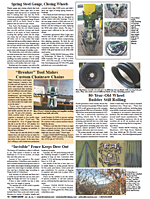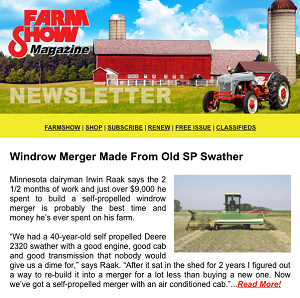First-Of-Its-Kind Giant Silage Bagger
"It lets you make big silage piles anywhere that can be used the year around with virtu-ally no spoilage," say Mark and Dan Walder, Wittenberg, Wis., about their first-of-itskind giant silage bagger that makes use of their "Silage Shaper" which was previously featured in FARM SHOW (Vol. 18, No. 1).
The Silage Shaper makes self-sealing stacks on flat ground or it can be mounted on the walls of a bunker silo. It consists of a 32-ft. wide, 16-ft. high metal truss lined with nylon canvas. A silo blower blows silage into the "shaper". You keep filling and moving the unit ahead until you've got the stack as big as you want. The silage packs itself, like in an upright silo.
"Weæve had a lot of interest in the Silage Shaper but 95% of the time we hear the same question: æIs there a way to cover the pile so we can use it all year long?', says Mark. "Most farmers who pile silage don't have a good way to cover them. Our new æbagger' covers the pile during the filling process. It works like an Ag Bagger only it makes a much bigger pile and is a lot less expensive. Ag Baggers sell for as much as $20,000. We plan to sell our unit for about $2,000. We tested it last year on haylage and oatlage and there was virtually no spoilage. The piles never even heated up.
"Our bagger uses a flat sheet of plastic that's rolled up around a flexible pipe and is equipped with seven roller clamps that hold the plastic up inside the arch. This de-sign keeps the plastic out of the wind as it's being fed out so it doesn't flap around. You pull the arch ahead with a cable winch anchored to a tractor. One person can move the unit 10 ft. ahead in only a few minutes. Then you tuck 2 to 3 ft. of plastic under the sides of the pile and you're ready to blow in 6 to 8 more loads of silage.
"As the pile settles during filling, it pushes the sides out, keeping the plastic as tight as it would be on an Ag Bagger. Once the pile is finished, we use a shop vac to pull out any extra oxygen under the plastic and to pull the plastic in tight so it won't blow around. We simply cut a small hole in the side of the plastic and insert the shop vac hose.
"The weight of the silage on the tucked-in plastic makes a perfect seal and eliminates the need for any extra tie-downs or old tires to hold the plastic down. The only side you have to seal is the front end of the pile. Any time during filling you can cut the plastic off, seal it, and start a new pile.
"When you feed out the silage piles, there's no plastic on the ground to get mixed in with the feed or wrapped around the loader tractor's tires. You can keep recovering the face of the pile.
"One $300 sheet of plastic covers the equivalent of six 150-ft. long bags or about 600 tons of silage."
Contact: FARM SHOW Followup, Dan and Mark Walder, 1525 S. Cty. Rd. I, Wittenberg, Wis. 54499 (ph 715 454-6458).

Click here to download page story appeared in.
Click here to read entire issue
First-Of-Its-Kind Giant Silage Bagger CROP STORAGE Bag Silos 20-1-3 "It lets you make big silage piles anywhere that can be used the year around with virtu-ally no spoilage," say Mark and Dan Walder, Wittenberg, Wis., about their first-of-itskind giant silage bagger that makes use of their "Silage Shaper" which was previously featured in FARM SHOW (Vol. 18, No. 1).
The Silage Shaper makes self-sealing stacks on flat ground or it can be mounted on the walls of a bunker silo. It consists of a 32-ft. wide, 16-ft. high metal truss lined with nylon canvas. A silo blower blows silage into the "shaper". You keep filling and moving the unit ahead until you've got the stack as big as you want. The silage packs itself, like in an upright silo.
"Weæve had a lot of interest in the Silage Shaper but 95% of the time we hear the same question: æIs there a way to cover the pile so we can use it all year long?', says Mark. "Most farmers who pile silage don't have a good way to cover them. Our new æbagger' covers the pile during the filling process. It works like an Ag Bagger only it makes a much bigger pile and is a lot less expensive. Ag Baggers sell for as much as $20,000. We plan to sell our unit for about $2,000. We tested it last year on haylage and oatlage and there was virtually no spoilage. The piles never even heated up.
"Our bagger uses a flat sheet of plastic that's rolled up around a flexible pipe and is equipped with seven roller clamps that hold the plastic up inside the arch. This de-sign keeps the plastic out of the wind as it's being fed out so it doesn't flap around. You pull the arch ahead with a cable winch anchored to a tractor. One person can move the unit 10 ft. ahead in only a few minutes. Then you tuck 2 to 3 ft. of plastic under the sides of the pile and you're ready to blow in 6 to 8 more loads of silage.
"As the pile settles during filling, it pushes the sides out, keeping the plastic as tight as it would be on an Ag Bagger. Once the pile is finished, we use a shop vac to pull out any extra oxygen under the plastic and to pull the plastic in tight so it won't blow around. We simply cut a small hole in the side of the plastic and insert the shop vac hose.
"The weight of the silage on the tucked-in plastic makes a perfect seal and eliminates the need for any extra tie-downs or old tires to hold the plastic down. The only side you have to seal is the front end of the pile. Any time during filling you can cut the plastic off, seal it, and start a new pile.
"When you feed out the silage piles, there's no plastic on the ground to get mixed in with the feed or wrapped around the loader tractor's tires. You can keep recovering the face of the pile.
"One $300 sheet of plastic covers the equivalent of six 150-ft. long bags or about 600 tons of silage."
Contact: FARM SHOW Followup, Dan and Mark Walder, 1525 S. Cty. Rd. I, Wittenberg, Wis. 54499 (ph 715 454-6458).
To read the rest of this story, download this issue below or click
here to register with your account number.








